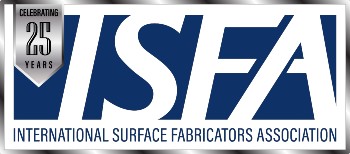Countertops Magazine ArchiveManagement Matters: Answering Architects' FAQsMANAGEMENT MATTERS: ANSWERING ARCHITECTS’ FREQUENTLY ASKED QUESTIONS ABOUT SOLID SURFACE Many architects are becoming very interested in using solid surface in their designs. Along with this interest, though, comes many questions. Being able to provide answers to these questions is very important. As architects plan out projects, they need to know how material will respond to their designs. Solid surface has a lot of great properties and can be used in a variety of ways for different projects. However, using it in an application that does not fit the capabilities of the material can lead to disastrous results. What follows is a list of some of the questions asked along with some starting points for accurate replies. Some of the questions will seem simple to a fabricator because they work with the product day in and day out, but an architect will need to familiarize themselves thoroughly with solid surface before they can utilize it effectively in their designs. Fabricators can also look at the questions below as a marketing tool. Seeing what questions architects are asking will also help you see what you can add to any sales presentations you might be developing to better appeal to them. 1. What is solid surface made of? 2. What are the standard sheet sizes and thicknesses of solid surface? Its worth noting that when you leave the ½ inch thickness standard you will generally have fewer color choices. Sheet sizes in ½ inch, ¾ inch, 2cm and 3cm can generally range from 120 inches to 144 inches long. Sheet sizes in ¼ inch stocks can range in size from widths of 30, 36, 48, and 60 inches wide by 96 inches long. Many manufactures will accommodate custom sizes if they see the project as desirable or it cost effective to do so, and some companies have specific programs just for commercial projects that can benefit from custom sheet sizes. 3. Can solid surface be bent or shaped? 4. Can I have a custom color made? 5. Can I get a solid surface sink in something other than a solid color? Another process used by some manufacturers is to pour the raw material in its liquid state into molds for a particular bowl shape. This enables the use of different colors. If you want a mold made, though, the cost can be quite high. 6. What types of finishes can I get? Any of the three finishes can be applied to any color. The general rule of thumb is the darker the color the more glossy the finish should be to enhance it. There are different ways to achieve the finishes. All begin with using sandpaper. A high gloss involves more work and requires buffing pads. 7. Can solid surface be joined to other materials? 8. Can solid surface be used outside? Effects of the sun – There can be some fading similar to what you would find in other outdoor materials. The key is to pick a color that will fade minimally, based on the manufacturer’s accelerated weathering tests. Hot to touch – Have you ever touched playground equipment on a hot summer day? On sunny days, solid surface gets warm like other materials. Proper education to the end use is advised. Maintaining integrity of the panels (cladding projects) – If not applied correctly serious structural issues can result with solid surface. A well thought-out structural plan is needed when solid surface is to be used in exterior cladding projects. Solid surface is making headlines. Its ability to work well with so many different designs makes it a perfect choice for architects and designers. It’s up to us, as fabricators, to make sure we have the answers architects may ask. I hope this article is a first step in the process. About the Author
|
